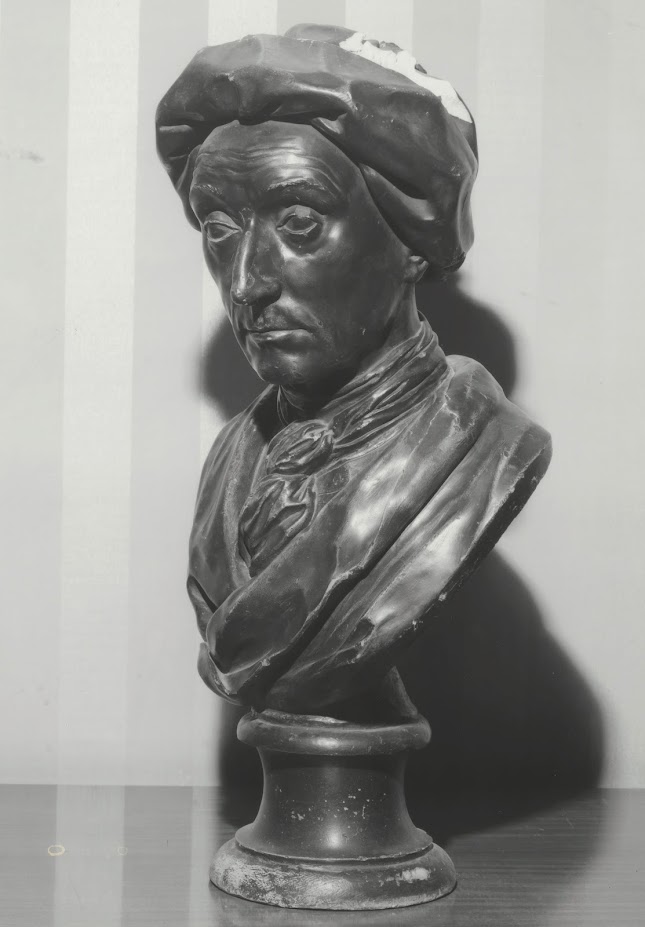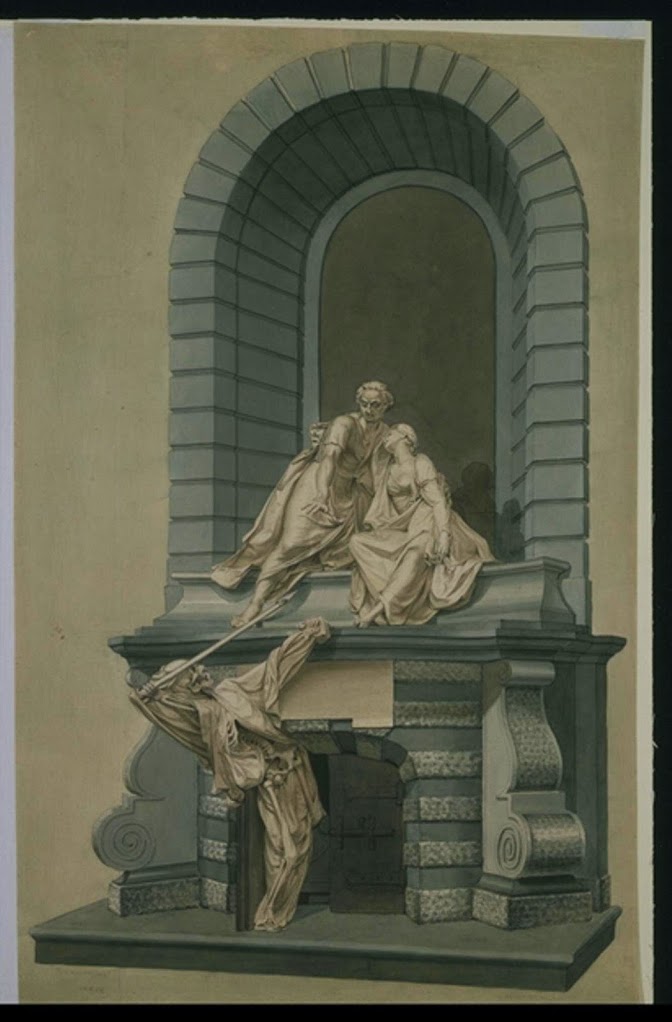The Roubiliac Marble Bust of Ligonier in the Royal Collection
and its recently reunited socle.
Some thoughts.
This post was prompted by my recent researches into the drawings of the busts in the Harris Museum and Art Gallery Preston and the subsequent reappraisal of my previous posts on the pair of Roubiliac busts Of Ligonier and George II in the Royal Collection in the light of the discovery of the original socle of the bust of George II.
....................................
The Nollekens Harris/ Preston Drawing of the bust of Lord Ligonier by Roubiliac.
Image below from the ART UK website.
John First Earl Ligonier (1680 - 1770).
Lord Ligonier.
The socle with the circular plate on this bust is similar to other Roubiliac busts.
For the marble bust of Lord Ligonier in the Royal Collection see my post
http://bathartandarchitecture.blogspot.com/2017/10/busts-of-george-ii-and-john-first-earl.html
The socle here is similar to that used on the Roubiliac Marble Bust of Andrew Fountaine on the monument at Narford, Norfolk (below), and to the marble busts of Andrew Fountaine and Martin Folkes by Roubiliac at Wilton House. Related to the medallions by Dassier
Andrew Fountaine Monument, Narford, Norfolk
Martin Folkes - Marble Wilton House.
The Roubiliac bust of Ligonier also employs the drapery pattern seen in two other late busts by Roubiliac – the bust of Thomas Coke, 1st Earl of Leicester (1697–1759), on Coke’s monument in St Mary, Tittleshall, Norfolk, (see below).
A plaster version with the standard socle is in the marble Hall at Holkham Norfolk;
The so called Fordham marble bust of Shakespeare in The Folger Library Washington DC. which was perhaps Lot 74, sold on the fourth day of the Roubiliac Sale on Saturday 15th May 1762. Given that there are no marble versions of the terracotta so called Davenant bust of Shakespeare (at the Garrick Club) and the bust donated to the BM by Matthew Maty, extant or mentioned elsewhere it seems a very distinct possibility that this was the Fordham bust.
https://bathartandarchitecture.blogspot.com/2016/01/the-folger-library-marble-bust-of.html
.........................................
The Bust of Lord Ligonier.
Roubiliac.
in the Royal Collection.

John, 1st Earl Ligonier, by Roubiliac
Provenance - by inheritance to Mrs Lloyd of Gloucester Place, London, by whom presented to George IV on 27 June 1817.
The socle has been replaced. see the image of the stairwell at Carlton House with the busts of Ligonier and George II on their original socles.
Malcolm Baker says Jonathan Marsden that the original socle for the bust of George II has reappeared.
Images here from
Royal Collection Website.
https://www.rct.uk/collection/35256/john-ligonier-1680-1770-1st-earl-ligonier
...............................
The NPG terracotta of Ligonier by Roubiliac.
https://www.npg.org.uk/collections/search/portrait/mw03912/John-Ligonier-1st-Earl-Ligonier
18" tall including the socle.
https://www.npg.org.uk/collections/search/portrait/mw03912/John-Ligonier-1st-Earl-Ligonier
..........................
the NPG say -
"NPG 2013 corresponds with the undated marble at Windsor incised L.F.Roubiliac sc. ad Vivum and must be the model. Mrs Esdaile places it possibly circa 1748 but more probably from the last years of the sculptor's life.
Roubiliac died 1762. Ligonier received the Bath in 1743 but sittings would have been difficult before the end of the war, 1748.
In 1926 W. T. Whitley discovered a contemporary reference to 'A Bust' of the sitter exhibited by Roubiliac at the Society of Artists 1761 (153) and an entry 3 February 1763 'To paid Mr Roubilliacs bill for £153 11s’has been found in the regimental account kept by Ligonier's agent Richard Cox. [2]
The payment, which must have been to the sculptor's estate, has been taken to refer to the Windsor marble, but unfortunately the supporting personal ledger where details might have been expected cannot be traced. [3]
Mrs Esdaile believed the marble was a royal commission; this is prima facie evidence to the contrary. Furthermore, according to Benjamin Justham, inventory clerk to George IV, the Roubiliac busts of Ligonier and George II were presented, 27 June 1817, by a Thomas Lloyd of 112 Gloucester Place, London. [4]
Four plasters and a mould of the bust were in the Roubiliac sale of 1762, lots 11 and 47 of the 1st day, lot 4 of the 3rd day and lots 9 and 17 of the 4th day. [5] These have since disappeared.
Condition: cracks at the base of the shoulders and in front, below the star of the Bath and in the fur above the centre line of the breastplate, have been repaired; an area at the edge of the collar on his left shoulder has been painted in; the tip of his left shoulder is damaged at the back; a few small areas of white visible in some of the valleys of the wig; 19th-century(?) rose-coloured plaster socle now faded.
Collections: bought 1924, from dealer Basil Dighton of 3 Savile Row, W1, and believed by him to be of Lord St Vincent. Mrs Esdaile, however, states that the bust had ‘passed from a dealer in Norwich to the vendor and been called Lord Howe'.
2. Letter, The Times, 28 December 1926, unpublished, NPG archives.
3. '1st Foot Guards Viscount Ligonier', f.137, archives of Messrs Lloyds Bank (Cox & King’s branch). Kindly verified by Mr M.A. Clancy, cp Whitworth, p.380 and note 2.
4. G. de Bellaigue, letter, 30 March 1972, NPG archives.
5. Esdaile, pp.219-27. [6]
...........................
A bust of Lord Ligonier was exhibited by Roubiliac at the Society of Artists in 1761.
No material was specified suggesting that this bust of Ligonier was most likely to be a terracotta, but it was possibly a plaster.
The Ligonier busts at the Roubiliac posthumous sale.
Three plaster busts were sold at the posthumous Roubiliac Sale at his house in St Martin's Lane on May 12 1762 and the following three days.For a transcript of the complete catalogue see below.
A plaster bust was sold on the first day - lot 11.
The mould was sold on the first day Lot 47.
Third day - Lot 4, A plaster bust of Ligonier.
Two plaster busts were sold on the fourth day - lots 9 and 17.
----------------
The Roubiliac Busts of Ligonier and George II at Carlton House.
Aquatint of the staircase well at Carlton House showing the two busts with their original socles
From Pyne's Royal Residences, 1819.
Engraver: Thomas Sutherland after Charles Wild.
Published by: W. H. Pyne, 36 Upper Charlotte Street, Fitzroy Square.
...........................
This section is of tangential relevance to the busts in the drawings but here is a convenient place to put these notes and images
A few notes on the original socles for the marble busts of Ligonier and George II.
The socles have been replaced sometime in the 1830's with turned socles with collars inscribed with the names of the subjects, along with several other socles on earlier busts in the Royal Collection such as the Alexander Pope bust by or after Roubiliac.
Jonathan Marsden has recently recorded that the original socle for the bust of George II has reappeared.
I am very grateful to Sally Goodsir Curator of Decorative Arts of the Royal Collection for informing me of the photograph below which shows the original socle now returned to the Roubiliac bust of George II.
For the Royal Collection photograph of the Roubiliac bust of George II reunited with its original socle which can be found on the Google Arts and Culture website -
https://artsandculture.google.com/asset/george-ii/UwHNTLDsfdTfkg?hl=en-GB&avm=2
The Roubiliac Bust of George II recently reunited with his original socle.
Royal Collection.
Roubiliac appears to have adapted the form of socle used in the 17th century on several busts by unidentified sculptors but possibly those by Peter Besnier. A pair of plaster busts from Easton Neston of Lord William and Lady Fermor, the bronze bust of Catherine Murray, Countess of Dysart at Ham House and the bronze bust of Venetia Lady Digby (private Collection) all have socles with volutes on either side.
Malcolm Baker, in an essay in the Burlington Magazine makes the case for the pair of busts being created especially for niches in the Gallery at Ligonier's house in 12 North Audley Street, Grosvenor Square (designed c 1728 / 1730 and attributed to Edward Lovett Pierce) with the socles made to echo the horizontal volutes on either side of the centre tablet of the Kentian chimneypiece.
I am not convinced I find this difficult to reconcile with the visual evidence. The niches at the ends of the gallery appear too tall and were probably intended to contain statues and the cupboards? either side of the chimneypiece appear to be too small in width.
12 North Audley Street Ground Floor Plan from -
https://www.british-history.ac.uk/survey-london/vol40/pt2/pp100-109#h3-0003
...............................
Some earlier Socles with Volutes.
This image from the Paul Mellon Archive.
One of a pair of busts of Charles I and Charles II.
It states stone but I believe they are plaster (to be confirmed).
Still at Euston Hall.
see my post.
http://english18thcenturyportraitsculpture.blogspot.com/2018/03/busts-of-charles-i-few-notes.html
............................
Catherine Murray The Duchess of Dysart (d.1649), Ham House, Richmond
attrib. Peter Besnier.
78 cms.
Probably at Ham before 1677.
Bronze Alloy.
Usual poor quality image courtesy National Trust.
The essay on the website is informative.
https://www.nationaltrustcollections.org.uk/object/1139887
....................
Bronze Bust of Venetia Lady Digby.
Private Collection.
see my post -
http://english18thcenturyportraitsculpture.blogspot.com/2017/11/the-bronze-busts-of-venetia-lady-digby.html
https://english18thcenturyportraitsculpture.blogspot.com/2017/10/bust-of-lady-venetia-digby-gothurst.html
...................................
A bust by de Keyser in the Rijksmuseum Amsterdam.
Included here to illustrate the form of an earlier Dutch socle with the volutes on either side of a cartouche.
.....................
The Bust of Charles I attributed to Dieussart
................................................
A pair of plaster busts from Easton Neston of Lord William and Lady Fermor,
attributed to Besnier (Bennier) d. 1693.
Sold at Sotheby's Easton Neston house sale Lot 12 - 17th May 2005.

































































.jpg)
